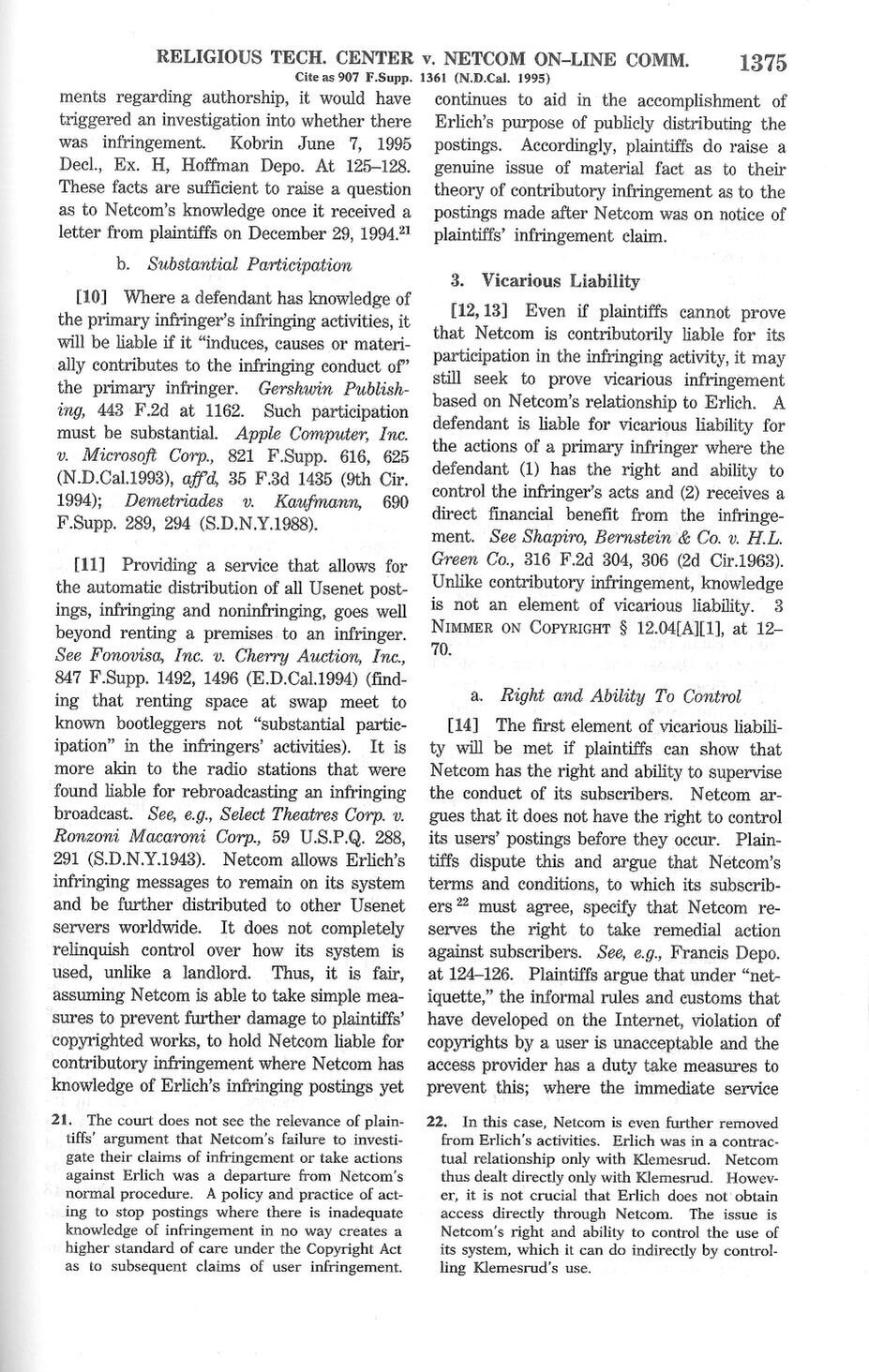Cite as 907 F.Supp. 1361 (N.D.Cal. 1995)
ments regarding authorship, it would have triggered an investigation into whether there was infringement. Kobrin June 7, 1995 Decl., Ex. H, Hoffman Depo. At 125–128. These facts are sufficient to raise a question as to Netcom’s knowledge once it received a letter from plaintiffs on December 29, 1994.[1]
b. Substantial Participation
Where a defendant has knowledge of the primary infringer’s infringing activities, it will be liable if it “induces, causes or materially contributes to the infringing conduct of” the primary infringer. Gershwin Publishing, 443 F.2d at 1162. Such participation must be substantial. Apple Computer, Inc. v. Microsoft Corp., 821 F.Supp. 616, 625 (N.D.Cal.1993), aff’d, 35 F.3d 1435 (9th Cir.1994); Demetriades v. Kaufmann, 690 F.Supp. 289, 294 (S.D.N.Y.1988).
Providing a service that allows for the automatic distribution of all Usenet postings, infringing and noninfringing, goes well beyond renting a premises to an infringer. See Fonovisa, Inc. v. Cherry Auction, Inc., 847 F.Supp. 1492, 1496 (E.D.Cal.1994) (finding that renting space at swap meet to known bootleggers not “substantial participation” in the infringers’ activities). It is more akin to the radio stations that were found liable for rebroadcasting an infringing broadcast. See, e.g., Select Theatres Corp. v. Ronzoni Macaroni Corp., 59 U.S.P.Q. 288, 291 (S.D.N.Y.1943). Netcom allows Erlich’s infringing messages to remain on its system and be further distributed to other Usenet servers worldwide. It does not completely relinquish control over how its system is used, unlike a landlord. Thus, it is fair, assuming Netcom is able to take simple measures to prevent further damage to plaintiffs’ copyrighted works, to hold Netcom liable for contributory infringement where Netcom has knowledge of Erlich’s infringing postings yet continues to aid in the accomplishment of Erlich’s purpose of publicly distributing the postings. Accordingly, plaintiffs do raise a genuine issue of material fact as to their theory of contributory infringement as to the postings made after Netcom was on notice of plaintiffs’ infringement claim.
- 3. Vicarious Liability
Even if plaintiffs cannot prove that Netcom is contributorily liable for its participation in the infringing activity, it may still seek to prove vicarious infringement based on Netcom’s relationship to Erlich. A defendant is liable for vicarious liability for the actions of a primary infringer where the defendant (1) has the right and ability to control the infringer’s acts and (2) receives a direct financial benefit from the infringement. See Shapiro, Bernstein & Co. v. H.L. Green Co., 316 F.2d 304, 306 (2d Cir.1963). Unlike contributory infringement, knowledge is not an element of vicarious liability. 3 Nimmer on Copyright § 12.04[A][1], at 12-70.
a. Right and Ability To Control
The first element of vicarious liability will be met if plaintiffs can show that Netcom has the right and ability to supervise the conduct of its subscribers. Netcom argues that it does not have the right to control its users’ postings before they occur. Plaintiffs dispute this and argue that Netcom’s terms and conditions, to which its subscribers[2] must agree, specify that Netcom reserves the right to take remedial action against subscribers. See, e.g., Francis Depo. at 124–126. Plaintiffs argue that under “netiquette,” the informal rules and customs that have developed on the Internet, violation of copyrights by a user is unacceptable and the access provider has a duty take measures to prevent this; where the immediate service
- ↑ The court does not see the relevance of plaintiffs’ argument that Netcom’s failure to investigate their claims of infringement or take actions against Erlich was a departure from Netcom’s normal procedure. A policy and practice of acting to stop postings where there is inadequate knowledge of infringement in no way creates a higher standard of care under the Copyright Act as to subsequent claims of user infringement.
- ↑ In this case, Netcom is even further removed from Erlich’s activities. Erlich was in a contractual relationship only with Klemesrud. Netcom thus dealt directly only with Klemesrud. However, it is not crucial that Erlich does not obtain access directly through Netcom. The issue is Netcom’s right and ability to control the use of its system, which it can do indirectly by controlling Klemesrud’s use.
